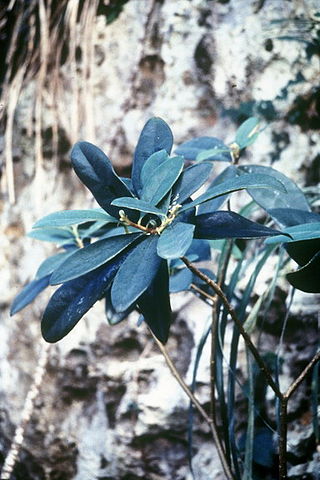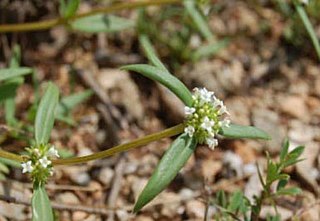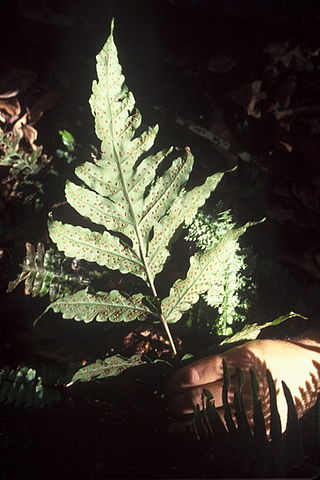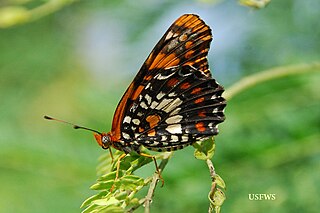
Cerro de Punta or Cerro Punta is the highest peak in Puerto Rico, rising to 1,338 meters (4,390 ft) above sea level. The mountain is part of the Cordillera Central and is located on the town boundary between the municipalities of Ponce and Jayuya in the central region of the main island of Puerto Rico.

The Cordillera Central is the only mountain range in the main island of Puerto Rico, consisting of three subranges: the western-central Cordillera Central, the southeastern Sierra de Cayey, and the northeastern Sierra de Luquillo. Bordered by the Northern Karst Belt to the northwest and costal plains to the north and south, the numerous ridges and foothills of the three subranges combined extend throughout the island. Concentrated in the western to central region of the island, the eponymous main subrange of Cordillera Central originates in the municipality of Mayagüez and merges with the Sierra de Cayey subrange on the town boundary between the municipalities of Barranquitas and Aibonito. At 1,338 meters on the town line between Ponce and Jayuya, Cerro de Punta is the summit of the Cordillera Central and the highest point in Puerto Rico.
Myrcia neothomasiana, commonly known as Thomas' lidflower, is a rare species of plant in the family Myrtaceae. It is found on three Caribbean islands. There are fewer than 250 individuals total divided amongst the islands of Vieques in Puerto Rico, St. John in the United States Virgin Islands, and Virgin Gorda in the British Virgin Islands. It has been extirpated from the wild on Saint Thomas, U.S. Virgin Islands, where it was first described in 1855, and now only grows there in cultivation.

Eugenia haematocarpa is a rare species of plant in the family Myrtaceae. It is endemic to Puerto Rico. It is classified as an endangered species by the U.S. Fish and Wildlife Service and there has been a plan for its recovery in place for some years. Its common names include uvillo and Luquillo Mountain stopper.
Pleodendron macranthum (chupacallos) is a rare species of tree in the family Canellaceae. It is endemic to Puerto Rico, where there are only three tiny populations remaining. Two individual plants are located in El Yunque and 8 to 10 plants remain in Río Abajo State Forest. This tree is a federally listed endangered species of the United States.

Schoepfia arenaria is an extremely rare species of hemiparasitic flowering plant in the Schoepfiaceae family. It grows as a small, multi-trunked tree. It is endemic to Puerto Rico, where it is found growing along the northern coast. A local Spanish vernacular name recorded for this tree is araña ('spider'). It has no common name in English.

Catesbaea melanocarpa is a rare species of flowering plant in the coffee family known by the common name tropical lilythorn. It is native to five Caribbean islands: Puerto Rico, St. Croix in the United States Virgin Islands, Antigua, Barbuda, and one island in Guadeloupe. The plant is threatened by habitat loss.

Cornutia obovata is a rare species of tree in the mint family, and formerly considered a member of the verbena family. It is endemic to forested slopes in Puerto Rico, where its common names are capá jigüerilla, nigua, and palo de nigua. When it was added to the endangered species list of the United States in 1988 there were only seven individuals known to remain in the wild. By 1998 there were eight plants known. This is considered one population divided amongst a few locations in the mountain forests of the island.
Cranichis ricartii is a rare species of orchid known by the common name Puerto Rico helmet orchid. It is native to Puerto Rico, where it is known from three locations in one forest. The plant has also been seen in Guadeloupe. The plant's rarity is the main reason for its listing as an endangered species of the United States.

Daphnopsis helleriana is a rare species of flowering plant in the genus Daphnopsis of the family Thymelaeaceae. It is endemic to Puerto Rico, where there were only four populations remaining in 1992, with a total of 125 individuals. It was federally listed as an endangered species of the United States in 1988.

Mitracarpus maxwelliae is a rare species of flowering plant in the coffee family known by the common name Maxwell's girdlepod. It is endemic to Puerto Rico, where it is known only from the Guánica Commonwealth Forest in Guánica. It grows in only one location in a coastal scrub forest and dwarf forest with limestone gravel substrates. Other plants in the habitat include Bucida buceras, Bursera simaruba, Exostema caribaeum, Coccoloba microstachya, Plumeria alba, and Pilosocereus royenii.

Mitracarpus polycladus is a rare species of flowering plant in the coffee family known by the common name cana gorda girdlepod. It is native to Puerto Rico, where it is known only to come from the Guánica Commonwealth Forest. It can also be found on the island of Saba. It grows in coastal scrub forest and dwarf forest with limestone gravel substrates. Other plants in the habitat include Bucida buceras, Bursera simaruba, Exostema caribaeum, Coccoloba microstachya, Plumeria alba, and Pilosocereus royenii.

Peperomia wheeleri is a rare species of flowering plant in the pepper family known by the common name Wheeler's peperomia. It is endemic to Puerto Rico, where it is known only from the island of Culebra. It has become rare because of deforestation and grazing by livestock. It is a federally listed endangered species of the United States.

Tectaria estremerana is a rare species of fern known by the common name Puerto Rico halberd fern. It is endemic to Puerto Rico. It is a federally listed endangered species of the United States.
Amauropelta inabonensis, synonym Thelypteris inabonensis, is a rare species of fern known by the common name cordillera maiden fern. It is endemic to Puerto Rico, where it is known from only two localities: at the headwaters of Río Inabón and at the Toro Negro State Forest. It is a federally listed endangered species of the United States.
Goniopteris verecunda, synonym Thelypteris verecunda, is a rare species of fern known by the common name Barrio Charcas maiden fern. It is endemic to Puerto Rico, where it is known from only three localities. It is a federally listed endangered species of the United States.

Goniopteris yaucoensis, synonym Thelypteris yaucoensis, is a rare species of fern known by the common name Puerto Rico maiden fern. It is endemic to Puerto Rico, where it is known from only three localities. It is a federally listed endangered species of the United States.

Vernonia proctorii is a rare species of flowering plant in the aster family known by the common name Proctor's ironweed. It is endemic to Puerto Rico, where there are two populations. It is threatened by the destruction of its habitat. It is a federally listed endangered species of the United States.

Atlantea tulita is a rare species of butterfly known by the common name Puerto Rico harlequin butterfly. This brush-footed butterfly is endemic to Puerto Rico. It is a candidate for United States federal protection as an endangered species. In 2011 a report found federal protection to be warranted, but it was precluded by other actions and it remains a candidate.

Carite State Forest is a state forest and nature reserve located in the Sierra de Cayey mountain range in southeastern Puerto Rico. The forest extends over approximately 2,600 hectares and is located in the municipalities of Caguas, Cayey, Guayama, Patillas and San Lorenzo. The forest is located along the Ruta Panorámica, which offers access to the forest.















